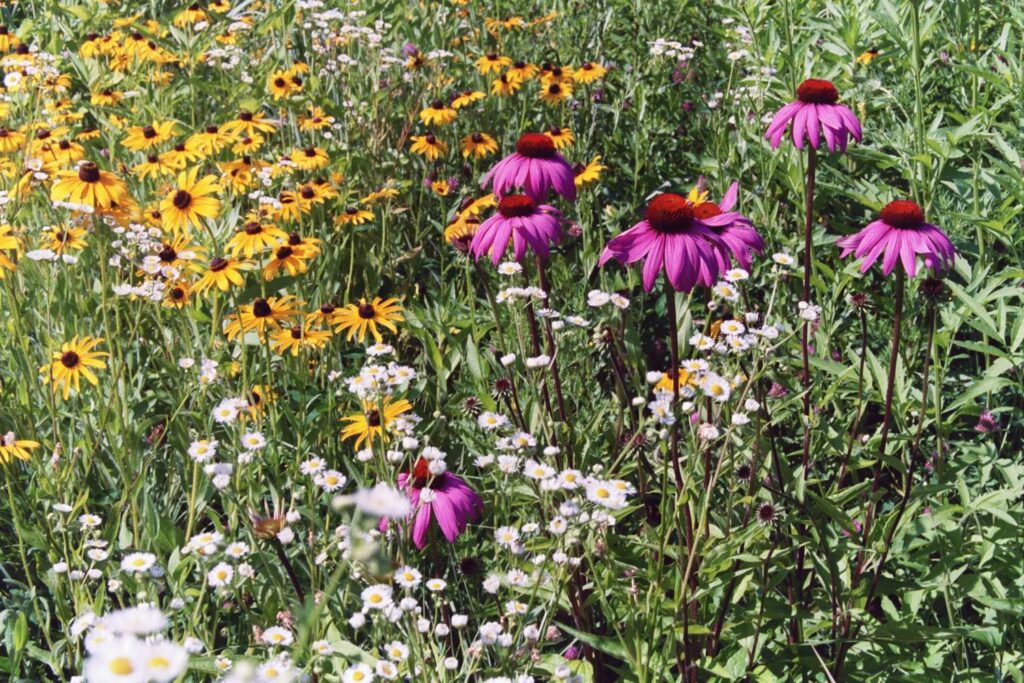Prairies are an interesting undertaking in the world of ecological restoration. While forested areas tower above with impressive trees and diverse wildlife, a different, exciting, and unique challenge presents itself when dealing with native prairies.
Prairies have long since been a symbol of the Midwest and even part of Indiana’s natural heritage. In fact, 15% of Indiana’s total land was historically native prairie! As protectors and restorers of Indiana’s natural areas, Red-tail Land Conservancy has taken on the task of giving certain protected areas a lesson in history by converting them to native prairie. So, what exactly does this mean? What does this process look like? Let’s find out.
Often due to a land’s historical usage, it usually needs to go through a series of preliminary burns, diskings, and mows. Burns in this case are both chemical and physical in nature. Often, chemical applications onto the land harbor quite an intense stigma, however the application of chemicals can be invaluable in clearing large sections of invasive plants. When used responsibly, chemical applications can be a powerful tool in restoring and managing native lands. This prepping stage could take over a year but is undoubtedly the most important in prairie restoration.
Over the coming years you may notice our staff mowing or even burning prairie areas to control invasive plant species. This may seem harsh, but the plants that establish themselves over years of being ignored are largely invasive. As such, overwhelming invasive species make for poor-quality areas and prevent our native plants from taking root. Native flora is essential to creating a healthy ecosystem that promotes animal diversity, varied niche space, and overall habitat vigor and stability. Simply put, the ends justify the means.
After invasive plant species have been eradicated as much as possible, prairie restoration moves into its next step, seeding! If all goes according to plan, our native seeds should germinate, take root, and establish themselves as the rightful owners of the land. Unfortunately, this process can take several growing seasons to complete. However, that does not mean there won’t be anything to observe in the meantime! Certain plants become established before others. Early prairie development can result in the land being covered in blankets of yellow from the black-eyed susans, pockets of wispy native grasses, and patches of pink and orange rising from the milkweed. Watching a native prairie grow and establish year after year can truly be a natural wonder.
The final process in all of this is a step where Red-tail arguably has the most important role: maintenance. After establishment, a key point in having a beautiful native prairie is having a management plan unique to the needs of the area. Most commonly, this means burning the land on a 3 to 5 year basis. Disturbance is crucial to Indiana native prairies and without it, trees and invasive plants encroach on the land. Disturbances in this case refer to floods, fires, landslides, and even insect outbreaks. Native prairie plants have evolved with frequent natural fires, so believe it or not, burning the area actually promotes a healthy prairie ecosystem!
When it is all said and done, native prairies are a beautiful gem within our community. You may be most familiar with Red-tail’s latest prairie restoration at Dutro-Ernst Woods in Muncie where all mentioned techniques have been employed.
Prairies are somewhere to walk your dog, take family picnics, or just enjoy the outdoors. These hard-earned restored areas provide space for pollinators, mammals, rare plants, and are some of the most diverse habitats in all of Indiana. However, it all starts and ends with prescribed disturbances of all varieties. So, don’t be alarmed if you see us mowing, burning, or disking the land, it is all part of our plan. And possibly most important to note, the first letter of prairie is a ‘P’ and that stands for “patience.”
Jake Gamble is the Stewardship Coordinator for Red-tail Land Conservancy. Impassioned by land conservation, he strives to protect and preserve the natural quality of Indiana while inspiring others to do the same.




